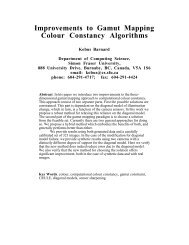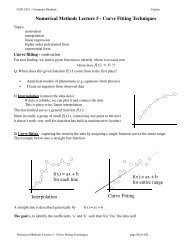1 Introduction
1 Introduction
1 Introduction
- No tags were found...
You also want an ePaper? Increase the reach of your titles
YUMPU automatically turns print PDFs into web optimized ePapers that Google loves.
1.5. Decision Theory 47Figure 1.28The regression function y(x),which minimizes the expectedsquared loss, is given by themean of the conditional distributionp(t|x).ty(x)y(x 0 )p(t|x 0 )x 0xExercise 1.25which is the conditional average of t conditioned on x and is known as the regressionfunction. This result is illustrated in Figure 1.28. It can readily be extended to multipletarget variables represented by the vector t, in which case the optimal solutionis the conditional average y(x) =E t [t|x].We can also derive this result in a slightly different way, which will also shedlight on the nature of the regression problem. Armed with the knowledge that theoptimal solution is the conditional expectation, we can expand the square term asfollows{y(x) − t} 2 = {y(x) − E[t|x]+E[t|x] − t} 2= {y(x) − E[t|x]} 2 +2{y(x) − E[t|x]}{E[t|x] − t} + {E[t|x] − t} 2where, to keep the notation uncluttered, we use E[t|x] to denote E t [t|x]. Substitutinginto the loss function and performing the integral over t, we see that the cross-termvanishes and we obtain an expression for the loss function in the form∫∫E[L] = {y(x) − E[t|x]} 2 p(x)dx + {E[t|x] − t} 2 p(x)dx. (1.90)The function y(x) we seek to determine enters only in the first term, which will beminimized when y(x) is equal to E[t|x], in which case this term will vanish. Thisis simply the result that we derived previously and that shows that the optimal leastsquares predictor is given by the conditional mean. The second term is the varianceof the distribution of t, averaged over x. It represents the intrinsic variability ofthe target data and can be regarded as noise. Because it is independent of y(x), itrepresents the irreducible minimum value of the loss function.As with the classification problem, we can either determine the appropriate probabilitiesand then use these to make optimal decisions, or we can build models thatmake decisions directly. Indeed, we can identify three distinct approaches to solvingregression problems given, in order of decreasing complexity, by:(a) First solve the inference problem of determining the joint density p(x,t). Thennormalize to find the conditional density p(t|x), and finally marginalize to findthe conditional mean given by (1.89).





